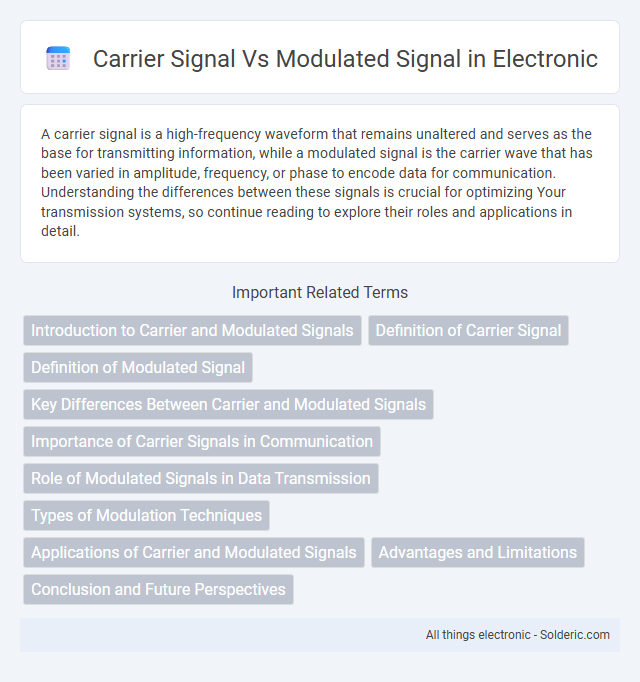A carrier signal is a high-frequency waveform that remains unaltered and serves as the base for transmitting information, while a modulated signal is the carrier wave that has been varied in amplitude, frequency, or phase to encode data for communication. Understanding the differences between these signals is crucial for optimizing Your transmission systems, so continue reading to explore their roles and applications in detail.
Comparison Table
| Feature | Carrier Signal | Modulated Signal |
|---|---|---|
| Definition | Unaltered high-frequency waveform used to carry information | Carrier signal modified by the information signal |
| Frequency | Constant, specific high frequency | Varies according to modulation type |
| Purpose | Provides a base for transmitting information over a distance | Encodes information for transmission |
| Information Content | None, it's a pure waveform | Contains the actual data or message |
| Amplitude | Constant amplitude | Amplitude varies if amplitude modulation is used |
| Phase | Constant phase | Phase varies if phase modulation is used |
| Frequency Change | Constant frequency | Frequency varies if frequency modulation is used |
Introduction to Carrier and Modulated Signals
Carrier signals are high-frequency sinusoidal waves that serve as the foundation for transmitting information in communication systems. Modulated signals result from altering the carrier signal's amplitude, frequency, or phase to encode the original data, enabling efficient transmission over various media. This modulation process ensures that the information can be effectively transmitted and retrieved at the receiver end.
Definition of Carrier Signal
A carrier signal is a high-frequency waveform, typically a sine wave, used in communication systems to carry information through modulation. It serves as the base frequency that is varied in amplitude, frequency, or phase to encode the desired data, resulting in a modulated signal. Without modulation, the carrier signal itself contains no information and functions solely as a transmission medium.
Definition of Modulated Signal
A modulated signal is an electromagnetic wave whose properties, such as amplitude, frequency, or phase, are altered to encode information for transmission. Unlike a carrier signal, which is a steady waveform with constant parameters, the modulated signal carries data by varying these attributes according to the message signal. Your communication system relies on modulated signals to efficiently transmit information over distances through radio waves or other media.
Key Differences Between Carrier and Modulated Signals
Carrier signals are unmodulated, continuous waveforms with fixed frequency, amplitude, and phase, serving as the baseline for information transmission. Modulated signals alter one or more properties of the carrier, such as amplitude (AM), frequency (FM), or phase (PM), to encode your data for communication systems. Understanding the key differences helps optimize signal processing by distinguishing the pure carrier from the information-bearing modulated signal.
Importance of Carrier Signals in Communication
Carrier signals serve as the foundational frequency that enables the transmission of information through modulation techniques such as amplitude modulation (AM) or frequency modulation (FM). They facilitate efficient signal propagation over long distances by shifting baseband signals to higher frequencies, minimizing interference and allowing better bandwidth utilization. The stability and strength of the carrier signal directly impact the clarity and reliability of the received modulated signal in communication systems.
Role of Modulated Signals in Data Transmission
Modulated signals play a crucial role in data transmission by encoding information onto a carrier signal through variations in amplitude, frequency, or phase, enabling efficient and reliable communication over long distances. Unlike the constant-frequency carrier signal, modulated signals carry actual data, allowing for multiplexing and improved bandwidth utilization. This modulation process minimizes signal degradation and interference, enhancing the integrity and clarity of the transmitted information across various communication channels.
Types of Modulation Techniques
Carrier signals serve as the unmodulated high-frequency waveforms used to transmit information, while modulated signals carry data by altering the carrier's properties through various modulation techniques. Common types include Amplitude Modulation (AM), where the carrier's amplitude varies with the input signal; Frequency Modulation (FM), which changes the carrier's frequency according to the data; and Phase Modulation (PM), which shifts the carrier's phase to encode information. Your choice of modulation technique depends on factors such as bandwidth efficiency, noise resistance, and application requirements.
Applications of Carrier and Modulated Signals
Carrier signals serve as the foundational frequency used in communication systems such as radio broadcasting, satellite transmissions, and wireless networks. Modulated signals, created by varying the carrier in amplitude, frequency, or phase, enable the transfer of information including voice, video, and data across mediums like television, mobile phones, and Wi-Fi. Your ability to receive and interpret diverse data streams relies on the precise modulation of these carrier signals to optimize bandwidth and reduce interference.
Advantages and Limitations
Carrier signals provide a stable frequency foundation essential for efficient transmission, enabling straightforward signal generation and minimizing power consumption in communication systems. Modulated signals carry encoded information, allowing for effective data transmission over long distances and resistance to noise interference, but they require more complex circuitry and signal processing techniques. The main limitation of carrier signals is their inability to convey information directly, while modulated signals face challenges such as bandwidth expansion and potential signal distortion.
Conclusion and Future Perspectives
The carrier signal serves as a constant frequency wave that enables efficient transmission of information, while the modulated signal carries the actual data by varying the carrier's properties such as amplitude, frequency, or phase. Future advancements in modulation techniques aim to enhance data throughput, improve signal robustness against interference, and optimize spectral efficiency for next-generation communication systems. Your understanding of these signals is crucial for leveraging emerging innovations in wireless technology and network performance.
carrier signal vs modulated signal Infographic

 solderic.com
solderic.com